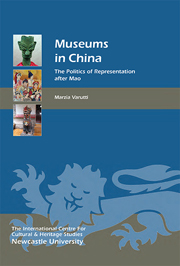Book contents
- Frontmatter
- Contents
- List of Illustrations
- Acknowledgments
- Chronology
- List of Abbreviations
- Introduction
- 1 Cultural Heritage in China
- 2 Museums in China: origins and Development
- 3 New Actors in the Chinese Museum World
- 4 Museum objects and the Chinese nation
- 5 The nation in the Museum
- 6 The Politics of the Past
- 7 The Representation of the Past in China's Museums
- 8 The Politics of identity
- 9 The Museum Representation of ethnic Minorities
- 10 Techniques and sites of Display of ethnic Minorities
- Conclusions: The new Museums of China
- Appendix: List of Museums in China Visited by the Author
- Bibliography and References
- Index
- Heritage Matters
10 - Techniques and sites of Display of ethnic Minorities
Published online by Cambridge University Press: 05 March 2014
- Frontmatter
- Contents
- List of Illustrations
- Acknowledgments
- Chronology
- List of Abbreviations
- Introduction
- 1 Cultural Heritage in China
- 2 Museums in China: origins and Development
- 3 New Actors in the Chinese Museum World
- 4 Museum objects and the Chinese nation
- 5 The nation in the Museum
- 6 The Politics of the Past
- 7 The Representation of the Past in China's Museums
- 8 The Politics of identity
- 9 The Museum Representation of ethnic Minorities
- 10 Techniques and sites of Display of ethnic Minorities
- Conclusions: The new Museums of China
- Appendix: List of Museums in China Visited by the Author
- Bibliography and References
- Index
- Heritage Matters
Summary
Mannequins, Miniatures and Dioramas as Display Techniques
The use of mannequins, miniatures, small-size figurines and dioramas is sufficiently wide-spread within ethnic minority displays in China to justify a critical reflection on their use and implications as display techniques. At the Museum of the Southwest University for Nationalities in Chengdu, the capital of the Sichuan Province in south-western China, the visitor can see the 56 Chinese ethnic groups represented by small-scale plastic figurines positioned side-by-side to form a materialised picture of the Chinese nation. This depiction is consistent with China's self-definition as a ‘multinational state’. The display technique adopted by the museum in Chengdu is not an isolated case; it can be found in a number of other Chinese museums exhibiting ethnic minority material culture.
The concept of the miniature (Lévi-Strauss 1962; Stewart 1984) is useful in exploring the agency of Chinese museums in shaping the image of ethnic minorities, as it reveals how specific museological practices and display techniques — such as mannequins, miniatures, dioramas, figurines and maps — enable the containment of ethnic minority cultural difference. In particular, following on from Tony Bennett's theory of museums as sites for the development of ‘civic seeing’, mannequins, figurines and miniatures in displays of Chinese ethnic minorities can be understood as devices aimed at imparting a ‘civic lesson’ (Bennett 2006b) on the ‘unity within diversity’ of the Chinese nation.
- Type
- Chapter
- Information
- Museums in ChinaThe Politics of Representation after Mao, pp. 145 - 158Publisher: Boydell & BrewerPrint publication year: 2014

